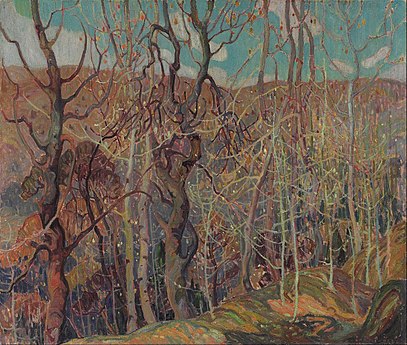Franklin Carmichael
This article includes a list of general references, but it lacks sufficient corresponding inline citations. (September 2008) |
Franklin Carmichael | |
|---|---|
 Frank Carmichael, 1930 | |
| Born | May 4, 1890 |
| Died | October 24, 1945 (aged 55) |
| Nationality | Canadian |
| Known for | Painting |
| Movement | Group of Seven |
Franklin Carmichael (May 4, 1890 – October 24, 1945) was a Canadian artist. He was the youngest original member of the Group of Seven.
Biography
The youngest of the Group of Seven, Franklin Carmichael was born in 1890 in Orillia, Ontario.[1] His father was a carriage maker.[1] Carmichael arrived in Toronto at the age of twenty and entered the Ontario College of Art, where he studied with William Cruickshank and George Reid. In 1911, he began working as an apprentice at Grip Ltd. for $2.50 a week. He then joined Tom Thomson and other painters who were training to become serious artists, joining them on weekend sketching trips. He moved to Belgium in 1913 to study painting but due to the war soon returned to his native Ontario to rejoin the other artists.[1] Carmichael was greatly influenced by Tom Thomson and shared space with him at the Studio Building in 1914.[2] He was also on the fringe of the group because of his difference in age and was closely associated with the newer members of the Group of Seven.
In 1915, Carmichael married Ada Lillian Went.
Along with A. J. Casson and F. H. Brigden, Carmichael founded the Ontario Society of Painters in Watercolour in 1925. He also founded the Canadian Group of Painters in 1933, which several members of the Group of Seven would later join. He taught at the Ontario College of Art from 1932 to 1945.
Famous for his watercolours, many of his paintings depict Ontarian landscapes. Contemporary Emily Carr considered Carmichael's work "A little pretty and too soft, but pleasant."[3] The Franklin Carmichael Art Group is located at 34 Riverdale Drive in Toronto.
A 44-x-55-cm watercolour entitled "Lone Lake" painted in 1929, considered to be the highlight of a major sale of Canadian art in May 2012 at Joyner Waddington's spring art auction in Toronto, ON, reached $330,400, including the 18 per cent auction house premium.[4] The subject of the painting is a small lake called Carmichael Lake in the La Cloche Mountains of Killarney Provincial Park near Sudbury, Ont.[5]
Death
Carmichael died in Toronto on October 24, 1945 and was buried at St. Andrew's and St. James Cemetery in Orillia, Ontario.[6]
Honours
Gallery
- Paintings by Franklin Carmichael
-
Autumn Hillside, oil on canvas, 1920
-
Silvery Tangle, oil on canvas, 1921
Further reading
- Boulet, Roger, "The Canadian Earth and Tom Thomson". M. Bernard Loates Cerebrus Publishing, 1982. National Library of Canada, AMICUS No. 2894383
- Harper, Russell. Painting in Canada: A History 2nd ed. Toronto: University of Toronto Press, 1981. ISBN 0-8020-6307-1
- Reid, Dennis A Concise History of Canadian Painting 2nd Edition. Toronto: Oxford University Press, 1988. ISBN 0-19-540663-X.
References
- ^ a b c Silcox, David P. (2003). "Introduction". The Group of Seven and Tom Thomson. Toronto, Ontario: Firefly Books Ltd. p. 19.
- ^ Klages, Gregory (2016). The Many Deaths of Tom Thomson: Separating Fact from Fiction. Toronto, Ontario: Dundurn Press. p. 207. ISBN 978-1-45973-196-7.
- ^ Carr, Emily (1966). "Meeting with the Group of Seven, 1927". Hundreds and Thousands: The Journals of an Artist. Toronto, Ontario: Irwin Publishing. p. 13. ISBN 0-7725-1617-0.
- ^ CBC News (May 25, 2012). "Modern and traditional art scores at Joyner auction: Buyers snap up Group of Seven, contemporary works in Toronto".
- ^ Boswell, Randy (April 28, 2012). "Group of Seven painting expected to fetch $350,000". Postmedia News.
- ^ http://www.findagrave.com/cgi-bin/fg.cgi?page=gr&GRid=113979348
- ^ "Members since 1880". Royal Canadian Academy of Arts. Retrieved 11 September 2013.


